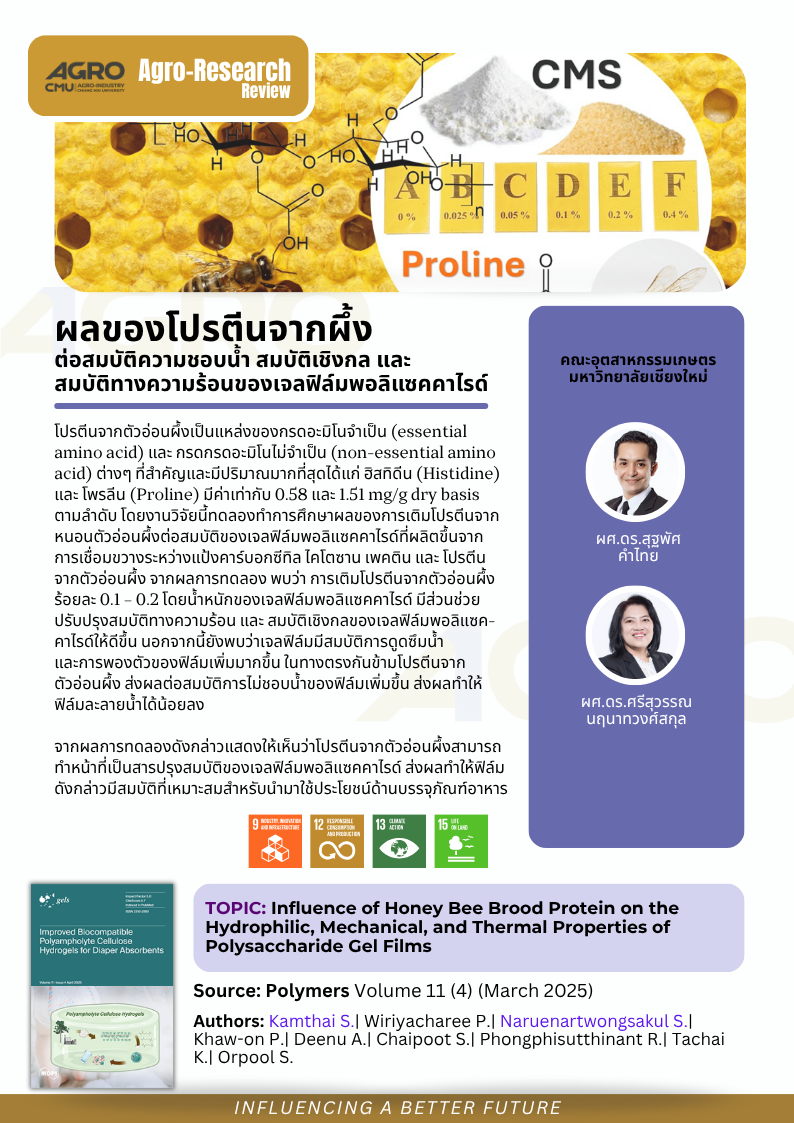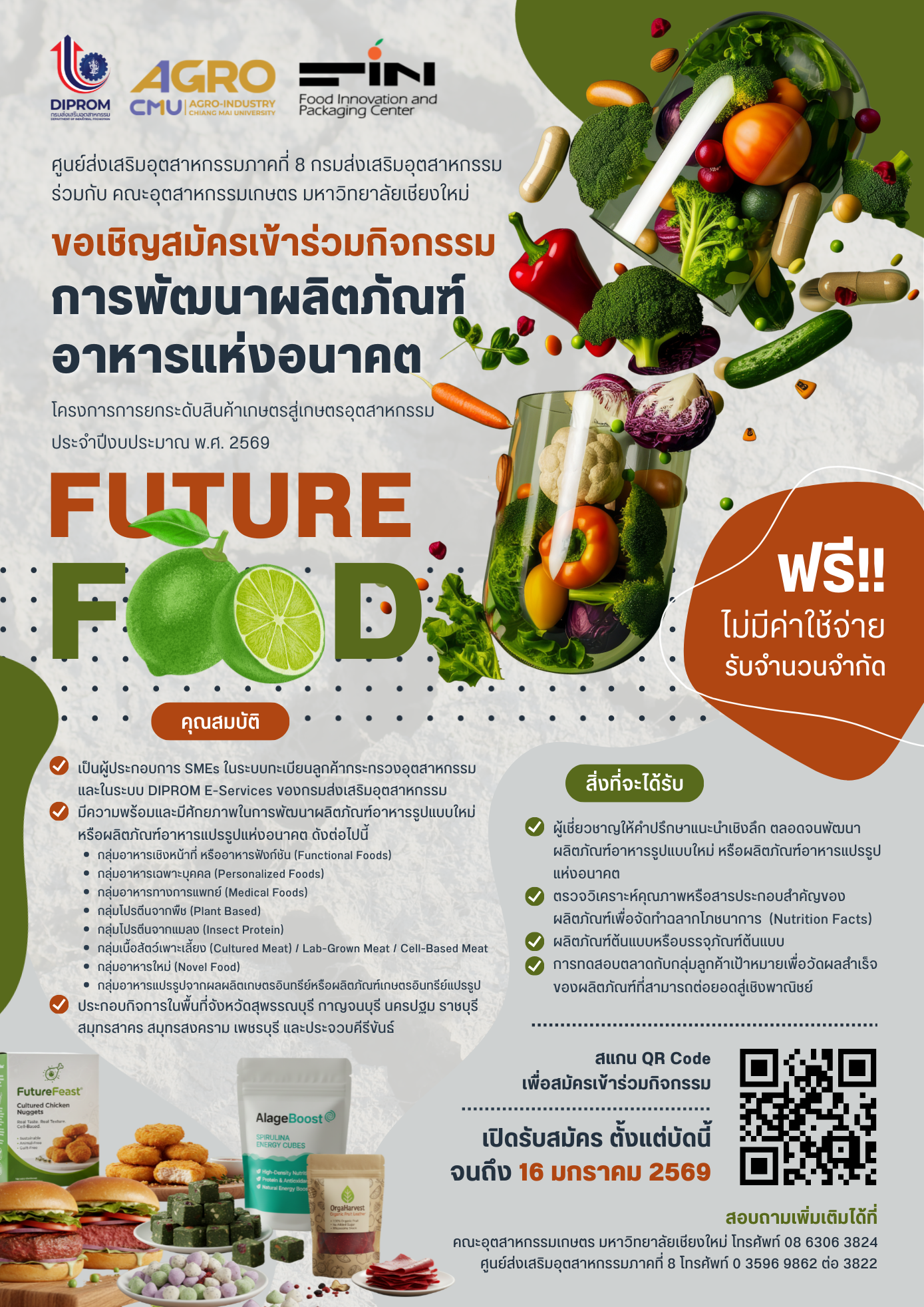
ผลของโปรตีนจากผึ้งต่อสมบัติความชอบน้ำ สมบัติเชิงกล และ สมบัติทางความร้อนของเจลฟิล์มพอลิแซคคาไรด์
โปรตีนจากตัวอ่อนผึ้งเป็นแหล่งของกรดอะมิโนจำเป็น (essential amino acid) และ กรดกรดอะมิโนไม่จำเป็น (non-essential amino acid) ต่างๆ ที่สำคัญและมีปริมาณมากที่สุดได้แก่ ฮิสทิดีน (Histidine) และ โพรลีน (Proline) มีค่าเท่ากับ 0.58 และ 1.51 mg/g dry basis ตามลำดับ โดยงานวิจัยนี้ทดลองทำการศึกษาผลของการเติมโปรตีนจากหนอนตัวอ่อนผึ้งต่อสมบัติของเจลฟิล์มพอลิแซคคาไรด์ที่ผลิตขึ้นจากการเชื่อมขวางระหว่างแป้งคาร์บอกซีทิล ไคโตซาน เพคติน และ โปรตีนจากตัวอ่อนผึ้ง จากผลการทดลอง พบว่า การเติมโปรตีนจากตัวอ่อนผึ้งร้อยละ 0.1 – 0.2 โดยน้ำหนักของเจลฟิล์มพอลิแซคคาไรด์ มีส่วนช่วยปรับปรุงสมบัติทางความร้อน และ สมบัติเชิงกลของเจลฟิล์มพอลิแซคคาไรด์ให้ดีขึ้น นอกจากนี้ยังพบว่าเจลฟิล์มมีสมบัติการดูดซึมน้ำ และ การพองตัวของฟิล์มเพิ่มมากขึ้น ในทางตรงกันข้ามโปรตีนจากตัวอ่อนผึ้งส่งผลต่อสมบัติการไม่ชอบน้ำของฟิล์มเพิ่มขึ้น ส่งผลทำให้ฟิล์มละลายน้ำได้น้อยลง ซึ่งจากผลการทดลองดังกล่าวแสดงให้เห็นว่าโปรตีนจากตัวอ่อนผึ้งสามารถทำหน้าที่เป็นสารปรุงสมบัติของเจลฟิล์มพอลิแซคคาไรด์ ส่งผลทำให้ฟิล์มดังกล่าวมีสมบัติที่เหมาะสมสำหรับนำมาใช้ประโยชน์ด้านบรรจุภัณฑ์อาหาร
Honey bee brood is a source of essential amino acid and non-essential amino acid, which mainly consist of histidine and proline. They were approximately 0.58 and 1.51 mg/g dry basis, respectively. This study focused on how adding protein from honey bee brood affects the properties of gel films made from a mix of carboxymethyl starch (CMS), chitosan, pectin, and honey bee brood protein. The results informed that the addition of bee larvae protein at 0.1% - 0.2% by weight of the polysaccharide gel film helped improve the thermal and mechanical properties of the polysaccharide gel film. Additionally, it was also discovered that the gel film had improved swelling and water absorption properties. On the other hand, the protein derived from honey bee brood alters the film's hydrophobic characteristics, which decreases its water solubility. The study's findings suggest that honey bee brood protein can act as an food additive for polysaccharide gel films, making the film suitable for use in food packaging applications.
Topic: Influence of Honey Bee Brood Protein on the Hydrophilic, Mechanical, and Thermal Properties of Polysaccharide Gel Films
Authors: Kamthai S.| Wiriyacharee P.| Naruenartwongsakul S.| Khaw-on P.| Deenu A.| Chaipoot S.| Phongphisutthinant R.| Tachai K.| Orpool S.
Abstract:
Growing concerns over the environmental impact of plastic packaging have driven interest in sustainable alternatives, particularly biopolymer-based films. This study developed ternary-blended polysaccharide gel films composed of carboxymethyl starch (CMS), chitosan (CS), and pectin (PT), with dialdehyde carboxymethyl cellulose (DCMC) as a crosslinker, and investigated the effects of honey bee brood protein (BBP) (0–0.4% w/v) on their mechanical, barrier, and thermal properties. A completely randomized design (CRD) was employed to evaluate the impact of BBP concentration on film characteristics. Results demonstrated that adding 0.4% BBP enhanced water vapor barrier properties and thermal stability while reducing hydrophilicity. The optimal formulation was observed at 0.1% BBP, providing the highest tensile strength (7.73 MPa), elongation at break (32.23%), and water-absorption capacity (369.01%). The improvements in thermal stability and hydrophilicity were attributed to BBP’s hydrophobic amino acids, which interacted with DCMC to form a denser polymer network, enhancing structural integrity and moisture resistance. Additionally, BBP incorporation contributed to the biodegradability of polysaccharide gel films, improving their environmental sustainability compared to conventional biopolymers. The findings suggest that BBP can serve as a functional additive in polysaccharide-based films, balancing performance and eco-friendliness for applications in biodegradable food and medical packaging.
Keywords: honey bee brood; polysaccharide; polysaccharide gel film; protein
View at publisher: https://www.mdpi.com/2310-2861/11/4/236
#อกมช. #agrocmu #CMU






